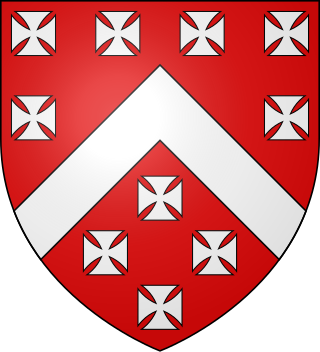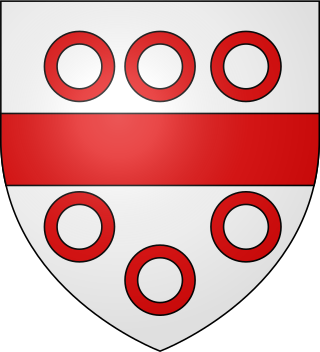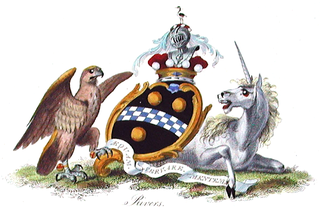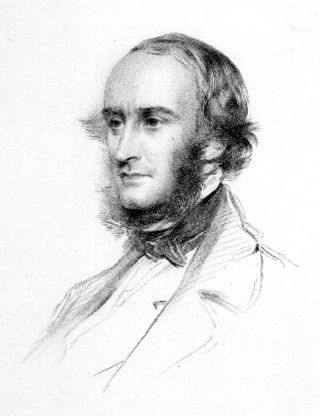
Duke of Bedford is a title that has been created six times in the Peerage of England. The first and second creations came in 1414 and 1433 respectively, both in favour of Henry IV's third son, John, who later served as regent of France. He was made Earl of Kendal at the same time and was made Earl of Richmond later the same year. The titles became extinct on his death in 1435. The third creation came in 1470 in favour of George Neville, nephew of Warwick the Kingmaker. He was deprived of the title by Act of Parliament in 1478. The fourth creation came in 1478 in favour of George, the third son of Edward IV. He died the following year at the age of two. The fifth creation came in 1485 in favour of Jasper Tudor, half-brother of Henry VI and uncle of Henry VII. He had already been created Earl of Pembroke in 1452. However, as he was a Lancastrian, his title was forfeited between 1461 and 1485 during the predominance of the House of York. He regained the earldom in 1485 when his nephew Henry VII came to the throne and was elevated to the dukedom the same year. He had no legitimate children and the titles became extinct on his death in 1495.

Thomas Wilde, 1st Baron Truro, was a British lawyer, judge, and politician. He was Lord High Chancellor of Great Britain between 1850 and 1852.

The title Baron Berkeley originated as a feudal title and was subsequently created twice in the Peerage of England by writ. It was first granted by writ to Thomas de Berkeley, 1st Baron Berkeley (1245–1321), 6th feudal Baron Berkeley, in 1295, but the title of that creation became extinct at the death of his great-great-grandson, the fifth Baron by writ, when no male heirs to the barony by writ remained, although the feudal barony continued. The next creation by writ was in 1421, for the last baron's nephew and heir James Berkeley. His son and successor William was created Viscount Berkeley in 1481, Earl of Nottingham in 1483, and Marquess of Berkeley in 1488. He had no surviving male issue, so the Marquessate and his other non-inherited titles became extinct on his death in 1491, whilst the barony passed de jure to his younger brother Maurice. However, William had disinherited Maurice because he considered him to have brought shame on the noble House of Berkeley by marrying beneath his status to Isabel, daughter of Philip Mead of Wraxhall, an Alderman and Mayor of Bristol. Instead, he bequeathed the castle, lands and lordships comprising the Barony of Berkeley to King Henry VII and his heirs male, failing which to descend to William's own rightful heirs. Thus on the death of King Edward VI in 1553, Henry VII's unmarried grandson, the Berkeley inheritance returned to the family. Therefore, Maurice and his descendants from 1492 to 1553 were de jure barons only, until the return of the title to the senior heir Henry, becoming de facto 7th Baron in 1553. Upon his death he was succeeded by his relative George Harding.

Baron Lucas is a title that has been created twice in the Peerage of England. The second creation is extant and is currently held with the title Lord Dingwall in the Peerage of Scotland.

Baron Stafford, referring to the town of Stafford, is a title that has been created several times in the Peerage of England. In the 14th century, the barons of the first creation were made earls. Those of the fifth creation, in the 17th century, became first viscounts and then earls. Since 1913, the title has been held by the Fitzherbert family.

Earl of Strafford is a title that has been created three times in English and British history.

Viscount St Vincent, of Meaford in the County of Stafford, is a title in the Peerage of the United Kingdom. It was created on 27 April 1801 for the noted naval commander John Jervis, Earl of St Vincent, with remainder to his nephews William Henry Ricketts and Edward Jervis Ricketts successively, and after them to his niece Mary, wife of William Carnegie, 7th Earl of Northesk. He had already been created Baron Jervis, of Meaford in the County of Stafford, and Earl of St Vincent, in the Peerage of Great Britain, on 23 August 1797, with normal remainder to his heirs male. On Lord St Vincent's death in 1823 the barony and earldom became extinct while he was succeeded in the viscountcy according to the special remainder by his nephew, the second viscount. In 1823 he assumed by royal licence the surname of Jervis in lieu of Ricketts. His great-grandson, the fourth viscount, was part of the force that was sent in 1884 to rescue General Gordon at Khartoum, and died from wounds received at the Battle of Abu Klea in January 1885. He was succeeded by his younger brother, the fifth viscount. As of 2013 the title is held by the eighth viscount, who succeeded his father in September 2006.

Viscount Bridport is a title that has been created twice, once in the Peerage of Great Britain and once in the Peerage of the United Kingdom. The first creation became extinct in 1814, while the second creation is still extant.

Duke of Leeds was a title in the Peerage of England. It was created in 1694 for the prominent statesman Thomas Osborne, 1st Marquess of Carmarthen, who had been one of the Immortal Seven in the Revolution of 1688. He had already succeeded as 2nd Baronet, of Kiveton (1647) and been created Viscount Osborne, of Dunblane (1673), Baron Osborne, of Kiveton in the County of York and Viscount Latimer, of Danby in the County of York, Earl of Danby, in the County of York (1674), and Marquess of Carmarthen (1689). All these titles were in the Peerage of England, except for the viscountcy of Osborne, which was in the Peerage of Scotland. He resigned the latter title in favour of his son in 1673. The Earldom of Danby was a revival of the title held by his great-uncle, Henry Danvers, 1st Earl of Danby.

The Dukedom of Chandos was a title that has been created twice in the Peerage of England. First created as a barony by Edward III in 1337, its second creation in 1554 was due to the Brydges family's service to Mary I during Wyatt's rebellion, when she also gave them Sudeley Castle. The barony was elevated to a dukedom in 1719, and it finally fell into abeyance in 1789, after 452 years.

Marquess of Ripon, in the County of York, was a title in the Peerage of the United Kingdom. It was created in 1871 for the Liberal politician George Robinson, 2nd Earl of Ripon.

Earl of Dartrey, of Dartrey in the County of Monaghan, was a title in the Peerage of the United Kingdom. It was created in July 1866 for The 3rd Baron Cremorne.

Viscount Clifden, of Gowran in the County of Kilkenny, Ireland, was a title in the Peerage of Ireland. It was created on 12 January 1781 for James Agar, 1st Baron Clifden. He had already been created Baron Clifden, of Gowran in the County of Kilkenny, in 1776, also in the Peerage of Ireland. The Viscounts also held the titles of Baron Mendip in the Peerage of Great Britain from 1802 to 1974 and Baron Dover from 1836 to 1899, when this title became extinct, and Baron Robartes from 1899 to 1974, when this title became extinct, the two latter titles which were in the Peerage of the United Kingdom. The interrelated histories of the peerages follow below.

Baron Rivers was a title that was created four times in British history, twice in the Peerage of England, once in the Peerage of Great Britain and once in the Peerage of the United Kingdom.
Baron Godolphin is a title that was created three times: first in the Peerage of England, next in the Peerage of Great Britain, and then in the Peerage of the United Kingdom.

Baron Colebrooke, of Stebunheath in the County of Middlesex, was a title in the Peerage of the United Kingdom. It was created in 1906 for Sir Edward Colebrooke, 5th Baronet. He held several positions at the British court. The Colebrooke family descended from the London banker James Colebrooke. His second son James Colebrooke represented Gatton in the House of Commons. On 12 October 1759 he was created a baronet, of Gatton in the County of Surrey, in the Baronetage of Great Britain, with remainder to his younger brother George. He was succeeded according to the special remainder by his younger brother George, the second Baronet. He was Member of Parliament for Arundel and also served as Chairman of the Honourable East India Company.

William Henry Forester Denison, 1st Earl of Londesborough, known as The Lord Londesborough from 1860 to 1887, was a British peer and Liberal politician. He was also one of the main founders of Scarborough FC.
Leopold George Frederick Agar-Ellis, 5th Viscount Clifden, known as Leopold Agar-Ellis until 1895, was a British Liberal politician.

The Earldom of Harborough was a title in the Peerage of Great Britain created in 1719 for Bennet Sherard, who had previously been made Baron Harborough (1714) and Viscount Sherard, with the viscountcy ending with the death of its original holder in 1732, but the other titles, created with special remainders to the grantee's cousin, persisted until 1859.
Sir Thomas Montague Morrison Wilde, 3rd Baron Truro was an English first-class cricketer and barrister.
















